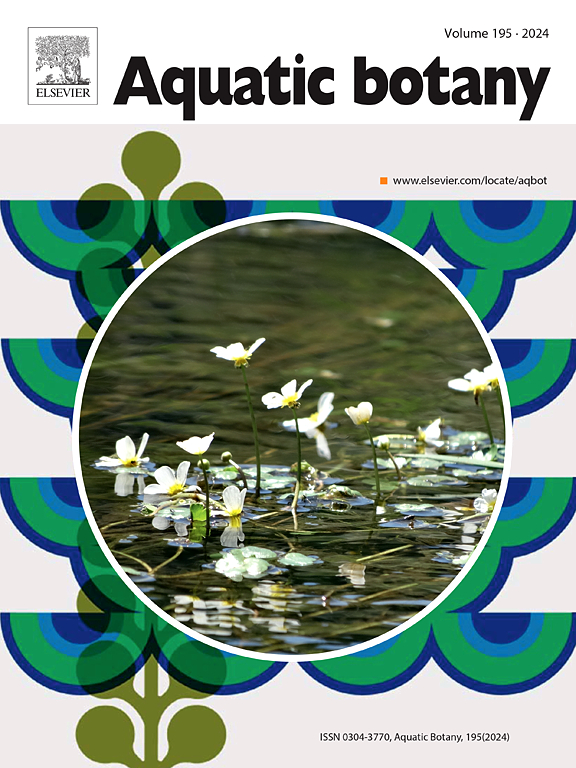海地焦蝇不同品系叶绿体基因组的比较分析
IF 2.6
4区 生物学
Q2 MARINE & FRESHWATER BIOLOGY
引用次数: 0
摘要
海檀焦皮(Pyropia haitanensis)是一种经济和营养意义重大的海洋作物,在中国广泛种植。本研究采用基因组skimming的方法,对15个不同菌株的海地紫檀叶绿体基因组序列进行了组装和注释,并对叶绿体基因组结构和特征进行了比较分析。组装的叶绿体基因组大小在195,577至201,312个碱基对(bp)之间,包含253个与光合作用,转录,生物合成和其他基本过程相关的基因(某些菌株为254个)注释。简单重复序列(SSRs)的数量在28 ~ 30个之间,其中AT是最丰富的双碱基重复序列。尽管叶绿体基因组结构总体上是保守的,但我们发现了8个高度可变的区域,可以作为区分海地紫檀不同菌株的潜在分子标记。这些区域是8个基因间间隔区:petJ-carA、ORF32-ycf35、rbl35-pbsA、ORF68-accB、psbB-psbT、syh-groEL、ORF107-ycf12、rpl32-ORF263。系统发育分析表明,15株菌株主要分为3个亚群,表明它们之间存在一定程度的遗传分化。总体而言,本研究不仅有助于了解海棠的遗传变异,而且为海棠的进一步研究、育种和利用提供了宝贵的资源。本文章由计算机程序翻译,如有差异,请以英文原文为准。
Comparative analysis of the chloroplast genomes of different strains of Pyropia haitanensis
Pyropia haitanensis, an economically and nutritionally significant marine crop, is extensively cultivated in China. This study employed genome skimming to assemble and annotate the chloroplast genome sequences of 15 different strains of P. haitanensis and conducted a comparative analysis of the chloroplast genome structure and characteristics. The assembled chloroplast genomes ranged in size from 195,577 to 201,312 base pairs (bp) and contained annotations for 253 (or 254 in some strains) genes associated with photosynthesis, transcription, biosynthesis and other essential processes. The number of simple repeat sequences (SSRs) varied between 28 and 30, with AT as the most abundant two-base repeat sequence. Despite overall conservation in the chloroplast genome structure, we identified eight highly variable regions that can serve as potential molecular markers for distinguishing different strains of P. haitanensis. These regions are eight intergenic spacer regions: petJ-carA, ORF32-ycf35, rbl35-pbsA, ORF68-accB, psbB-psbT, syh-groEL, ORF107-ycf12, rpl32-ORF263. Phylogenetic analysis indicates that the 15 strains mainly divide into three subgroups, suggesting a degree of genetic differentiation among them. Overall, this study not only contributed to the understanding of the genetic variation of P. haitanensis, but also offered valuable resources for future research, breeding efforts, and utilization of this economically important marine crop.
求助全文
通过发布文献求助,成功后即可免费获取论文全文。
去求助
来源期刊

Aquatic Botany
生物-海洋与淡水生物学
CiteScore
3.80
自引率
5.60%
发文量
70
审稿时长
6 months
期刊介绍:
Aquatic Botany offers a platform for papers relevant to a broad international readership on fundamental and applied aspects of marine and freshwater macroscopic plants in a context of ecology or environmental biology. This includes molecular, biochemical and physiological aspects of macroscopic aquatic plants as well as the classification, structure, function, dynamics and ecological interactions in plant-dominated aquatic communities and ecosystems. It is an outlet for papers dealing with research on the consequences of disturbance and stressors (e.g. environmental fluctuations and climate change, pollution, grazing and pathogens), use and management of aquatic plants (plant production and decomposition, commercial harvest, plant control) and the conservation of aquatic plant communities (breeding, transplantation and restoration). Specialized publications on certain rare taxa or papers on aquatic macroscopic plants from under-represented regions in the world can also find their place, subject to editor evaluation. Studies on fungi or microalgae will remain outside the scope of Aquatic Botany.
 求助内容:
求助内容: 应助结果提醒方式:
应助结果提醒方式:


